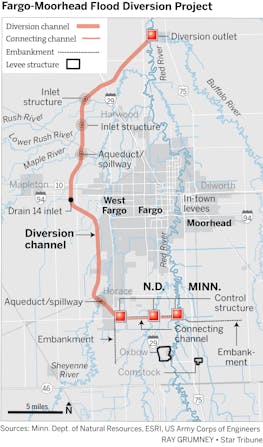The path is now clear for the construction of the $2.75 billion Red River diversion project that intends to provide permanent, reliable flood protection to the Fargo-Moorhead metropolitan area.
A big administrative hurdle was cleared Wednesday with the approval of a permit from the Minnesota Department of Natural Resources (DNR).
The 30-plus-mile-long project has been stalled for years with legal battles between urban dwellers — who see the frequent flooding of the Red River as an ongoing threat to Fargo, the economic hub for the region — and farmers and rural residents to the south, whose farms soon could be flooded and lives disrupted during major flooding events.
The massive project would, in the event of a severe flood threat, channel floodwaters from the north-flowing Red River and its five tributaries around Fargo. The 36-mile ditch would divert floodwaters away from developed areas, while a flood control dam would back floodwaters up into farmlands and prairie on both sides of the river to the south. The project spans some 30,000 acres and will protect a quarter million people — as well as $20 billion worth of property — from flooding.
The Metro Flood Diversion Authority (MFDA) announced Wednesday that the DNR affirmed its decision to grant the dam safety and public waters work permit. That permit was originally issued in 2018, but opponents of the project appealed it, which halted construction of some elements of the project.
"The permit allows us to work directly with affected Minnesota landowners and provide them with certainty of project impacts and property rights acquisition needs," said Joel Paulsen, executive director of the MFDA. "Now, with the affirmation of the permit, our team is ready to act."
Settlement reached
A settlement was reached in October that ended the court battle. The biggest part of the settlement was the establishment of a $75 million economic relief fund for two counties south of Fargo: Richland County, N.D., and Wilkin County, Minn.
That fund will be used to compensate those counties for areas that will no longer be developable. In addition, the settlement included insuring farmers, landowners and business owners that could suffer losses during a severe flooding event. It also included flood-mitigation measures in several surrounding communities.
The settlement ended years of drawn-out lawsuits and allowed the DNR to move forward with the permitting process.
The seeds of the project were planted in 2008, when a group of residents from around the Fargo metropolitan area met with the Army Corps of Engineers to discuss options for protecting the area from severe flooding.
The Buffalo-Red River Watershed District is especially prone to flooding for several reasons. Because the Red River flows north, that means the northern stretches of the river are often still frozen in spring, so ice dams can build up. Plus the region lies in the area that some 13,000 years ago was Lake Agassiz. When the large glacial lake drained, it left behind a wide and perfectly flat swath of land. Because the area is so flat, floodwaters spread especially quickly.
The 2009 Red River Flood nearly wiped out the metropolitan area. Due to a perfect storm of conditions — saturated and frozen ground, spring snowmelt and additional rain — the river crested at nearly 41 feet in Fargo.
"It doesn't take much water to flood a big area," said Gerald Van Amburg, manager of the Buffalo-Red River Watershed District. "We came within inches of being totally wiped out."
Bidding is next step
The DNR permit requires the diversion authority to obtain property rights for land impacted by the project up to the probable maximum flood event.
"That's where the opposition was, people saying you're going to be harming our farmland, putting water on it, slowing down planting in spring — just lots of opposition," Van Amburg said.
The next step is the selection of a construction bid through a public-private partnership. The bid ought to be announced in April, with construction starting in fall 2021 and continuing through 2027.
"You get into that mode of litigation and it seems like it never ends: always another court case, another court hearing," Paulsen said. "Now we can focus on what we were hired to do. It's a light at the end of a very long tunnel."
Reid Forgrave • 612-673-4647
DFL state senator charged with first-degree burglary in break-in at stepmother's home
In heated western Minn. GOP congressional primary, outsiders challenging incumbent
Driver pulled from burning car on I-94 in St. Paul thanks Good Samaritans for saving life
House fire on rural property north of St. Cloud claims man, 76


